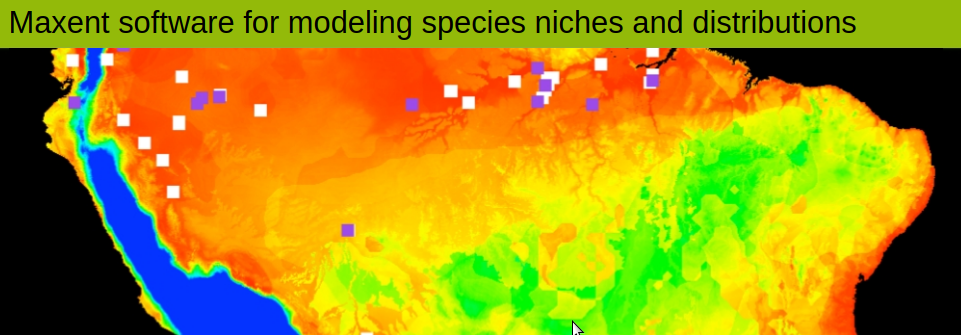
Maxent is now open source!
Use this site to download Maxent software for modeling species niches and distributions by applying a machine-learning technique called maximum entropy modeling. From a set of environmental (e.g., climatic) grids and georeferenced occurrence localities, the model expresses a probability distribution where each grid cell has a predicted suitability of conditions for the species. Under particular assumptions about the input data and biological sampling efforts that led to occurrence records, the output can be interpreted as predicted probability of presence (cloglog transform), or as predicted local abundance (raw exponential output).
Here you can download the open-source release of Maxent (under an MIT license; suggested citation below). See below for key changes in the current version.
The idea for Maxent was first conceived of here at the Center for Biodiversity and Conservation at the American Museum of Natural History (AMNH) through a public-private partnership between the AMNH and AT&T-Research. Steven Phillips and the other developers of Maxent are still engaged in its development and maintenance, and the Google group will remain the main mechanism for user questions. Much additional information can be found in the Google group, software tutorials, and other resources listed below.
Main changes in Version 3.4.4
- Minor bug fix..
Main changes in Version 3.4.3
- Fixed a bug that was causing abrupt changes in response curves for some floating -point predictor variables, due to the "add samples to background" option not adding all samples for floating-point predictors.
Main changes in Version 3.4.2
- Fixed bug that causes nodoclamp flag not to work for dismo's predict method for MaxEnt objects
Main changes in Version 3.4.1
- Minor bug fixes to the 3.4.0 release
Main changes in Version 3.4.0
- Released under a MIT license**
- Threshold features are now turned off by default
- A cloglog transform has been added and now constitutes the default transformation for model output (formerly the logistic transform)
Download
- Current tutorial in English (5.7 MB)
- Tutorial data (12.2 MB)
- Version 3.2.0 Spanish translation, provided by Paolo Ramoni-Perazzi (1.6 MB)
- Version 3.2.0 Spanish translation, modified version provided by Jose Marrero (1.6 MB)
- Version 3.2.0 Russian translation, provided by Maxim Dubinin
- coverages.zip (3.8 MB) - the coverages used in modeling.
- ipcc.zip (10.8 MB) - the raw ipcc data, as dowloaded from the IPCC Data Distribution Centre. Also the annual and monthly variables used for the study, extracted from the raw ipcc data and converted into world-wide coverages in .asc format.
- samples.zip (9.5 kB) - the training and testing sample localities used.
Discussion Group
There is a long-standing google discussion group for users of this software at http://groups.google.com/group/Maxent. Sign up for this group for discussions and questions about the software, and also to get information about updates, bugs, etc.
Tutorial
A tutorial explaining how to use this software is provided in the download section as a PDF. The data that go along with this tutorial are available as a zip file.
If you would like to reference the tutorial in a publication, report, or online posting, an appropriate citation is:
Steven J. Phillips. 2017. A Brief Tutorial on Maxent. Available from url: http://biodiversityinformatics.amnh.org/open_source/maxent/. Accessed on .
A teaching exercise using a previous version of Maxent can be downloaded from the AMNH website:
Additional teaching resources regarding Maxent can be found on Robert P. Anderson's site
Maxent species distribution modeling approach publications
- Steven J. Phillips, Robert P. Anderson, Miroslav Dudík, Robert E. Schapire, Mary Blair. 2017. Opening the black box: an open-source release of Maxent. In Ecography. PDF
- Steven J. Phillips, Robert P. Anderson, Robert E. Schapire. 2006. Maximum entropy modeling of species geographic distributions. Ecological Modelling, 190:231-259, 2006. PDF *Datasets used in this paper are available in the download section
- Steven J. Phillips, Miroslav Dudík, Robert E. Schapire. 2004. A maximum entropy approach to species distribution modeling. In Proceedings of the Twenty-First International Conference on Machine Learning, pages 655-662. PDF
- Additional key references regarding Maxent
- Jane Elith, Steven J. Phillips, Trevor Hastie, Miroslav Dudík, Yung En Chee, and Colin J. Yates. 2011. A statistical explanation of MaxEnt for ecologists. Diversity and Distributions, 17:43-57. PDF
- Corey Merow, Matthew J. Smith, and John A. Silander, Jr. 2013. A practical guide to MaxEnt for modeling species’ distributions: what it does, and why inputs and settings matter. Ecography, 36: 1058–1069. PDF
- Aleksandar Radosavljevic and Robert P. Anderson. 2014. Making better Maxent models of species distributions: complexity, overfitting, and evaluation. Journal of Biogeography, 41: 629–643. PDF